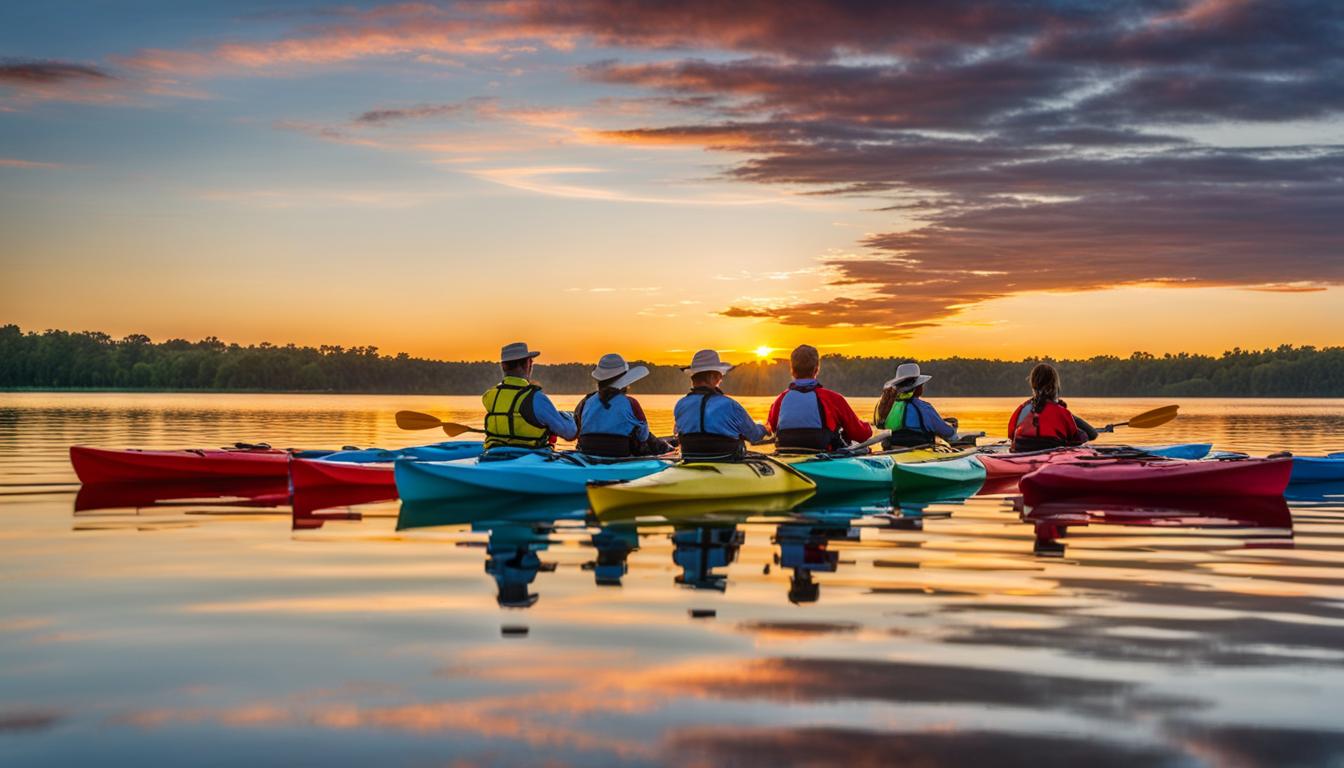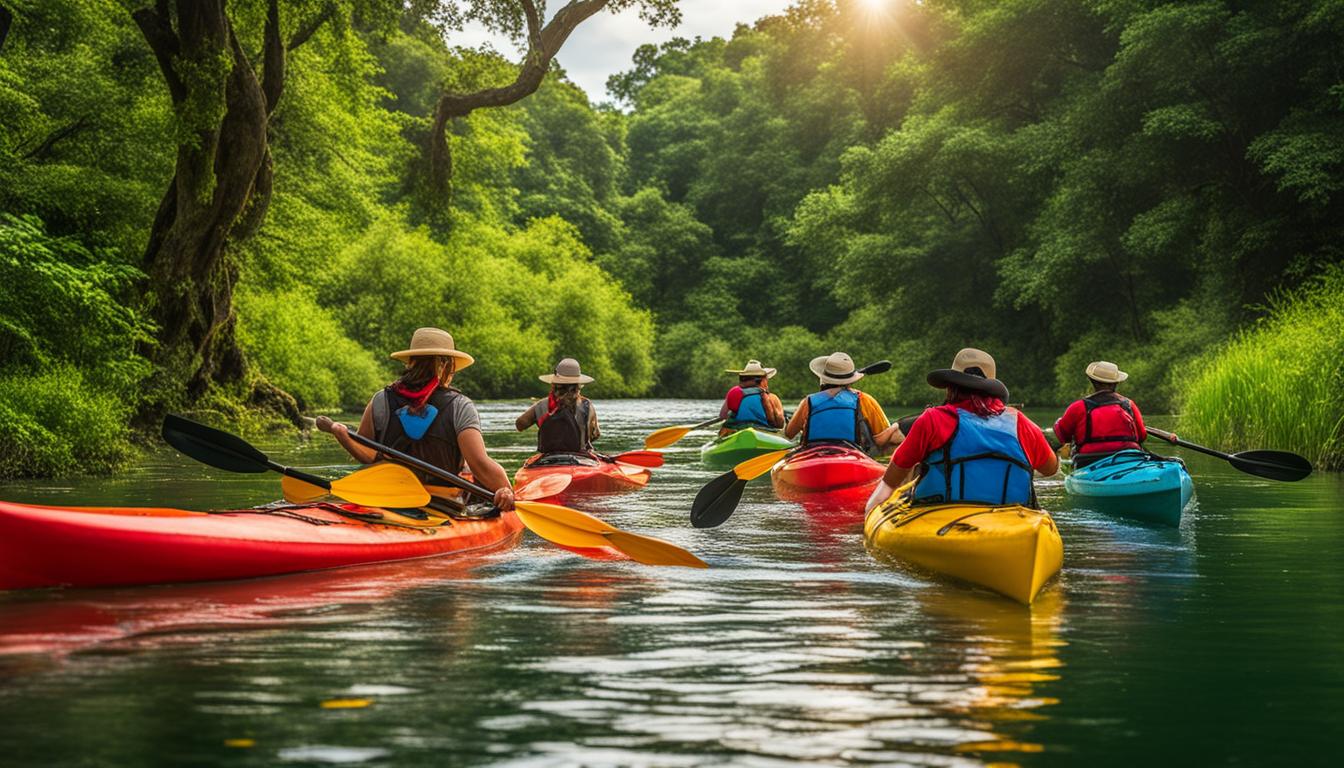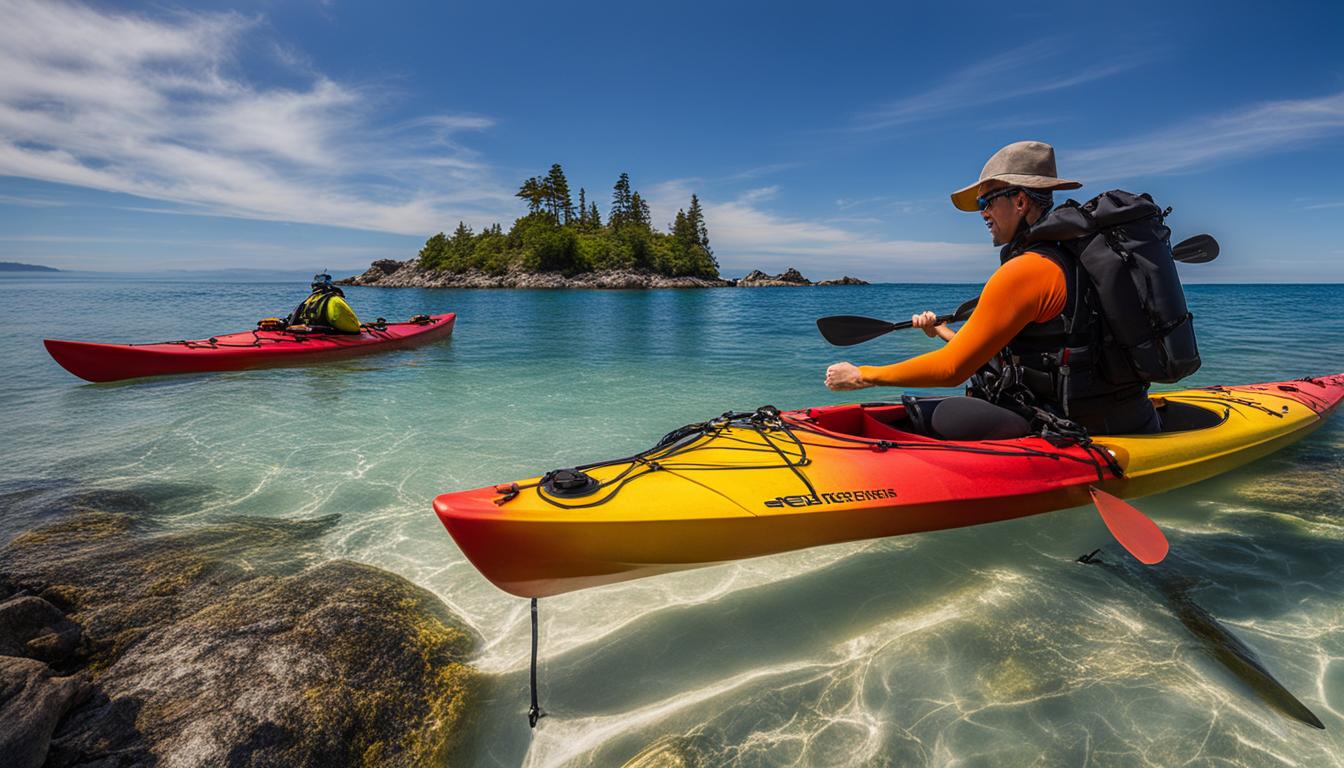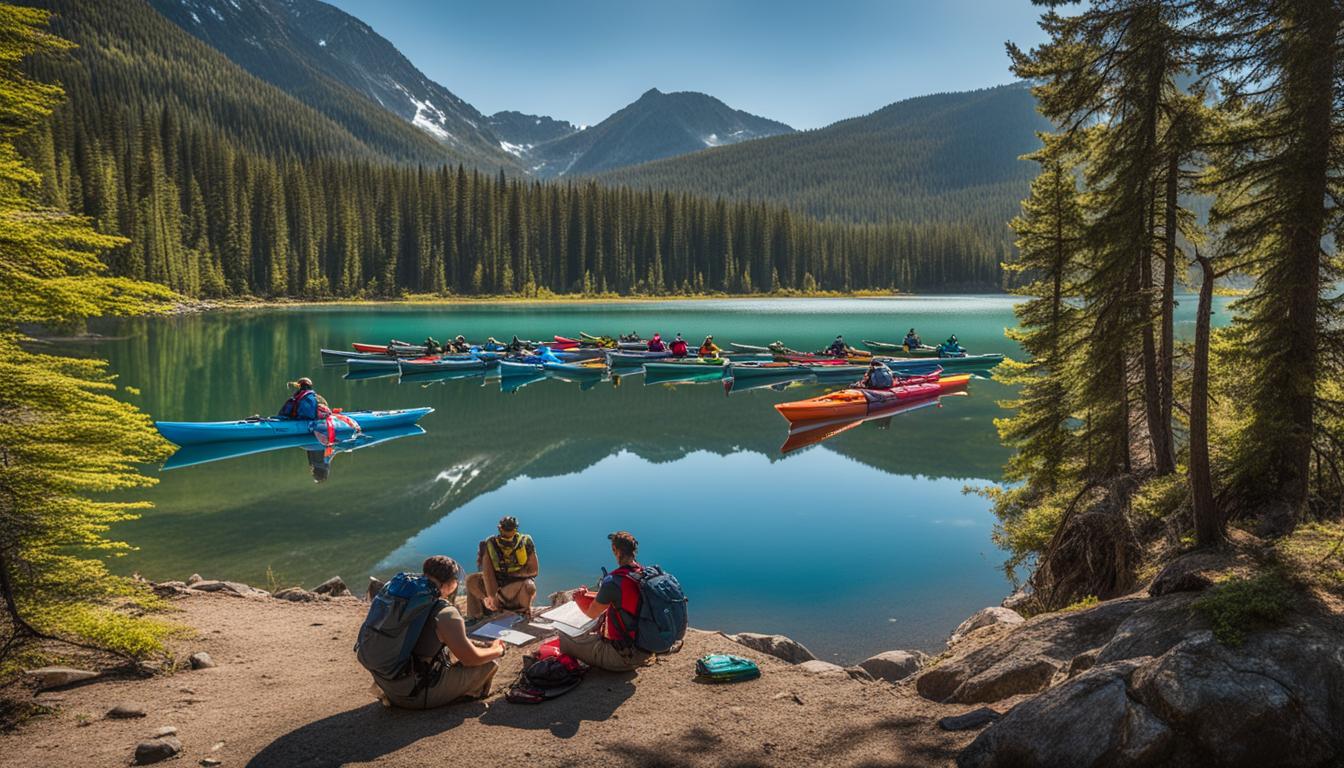Planning a kayak trip with friends can be an exciting endeavor, filled with opportunities for adventure and bonding. However, organizing a group kayak expedition requires careful thought and preparation to ensure a smooth and enjoyable experience for everyone involved. In this article, we will provide you with valuable tips and ideas to help you navigate the challenges of group kayak camping and create unforgettable memories with your friends.
Key Takeaways:
- Properly packing essential gear is crucial for a successful group kayak camping trip.
- Consider group dynamics and establish clear leadership and communication within the group.
- Create a suitable itinerary that caters to the skill levels and interests of the group.
- Prioritize safety practices, such as wearing personal flotation devices and practicing kayak rescue techniques.
- Select a campsite that provides easy access to the water and meets the needs of the group.
Packing for Group Kayak Camping
When it comes to group kayak camping, packing the right gear is essential for a successful and enjoyable trip. Here are some important items to include in your packing list:
Clothing
- Baselayers: Choose moisture-wicking and quick-drying materials to keep you comfortable.
- Camp pants: Opt for lightweight and durable pants that offer flexibility for movement.
- Fleece mid-layers: Pack a warm and insulating layer for colder nights.
- Warm puffy jacket: Bring a lightweight and compressible jacket to stay cozy in chilly weather.
- Raincoat and pants: Ensure you have waterproof and breathable outer layers to protect you from rain.
Essentials
- Wetsuit or drysuit: Depending on the water temperature, pack a wetsuit or drysuit to stay warm and protected.
- Sleeping bag, liner, and pad: Choose a sleeping bag suitable for the camping conditions and bring a liner for added warmth. Don’t forget a comfortable sleeping pad for a restful night’s sleep.
- Tent or hammock camping setup: Decide which option works best for your group and ensure you have a suitable shelter.
- Camp stove and cook kit: Pack a portable stove and cookware for preparing meals at your campsite.
- Water dromedary: Stay hydrated by bringing a water container that can hold a sufficient amount of water for the duration of your trip.
Safety Equipment
- Kayak and personal flotation devices (PFDs): Every member of your group should have a kayak and a properly-fitted PFD.
- Local weather reports: Stay informed about the weather conditions in your area to plan accordingly.
- First aid kit: Carry a well-stocked first aid kit that includes essential supplies for any potential injuries or emergencies.
- Spare paddle: It’s always a good idea to have an extra paddle in case one gets lost or damaged.
- Bilge pump: Bring a bilge pump to remove any water that may accumulate in your kayak.
- Signaling devices and throw line or tow rope: Be prepared with signaling devices such as a whistle or a mirror, as well as a throw line or tow rope for rescue situations.
By packing these essential items and ensuring everyone in your group has the necessary gear, you’ll be well-prepared for a successful and enjoyable group kayak camping trip.
Considering Group Dynamics
When planning a group kayak camping trip, it’s important to take into account the dynamics within your group. Understanding how to effectively lead and communicate, assign responsibilities, and promote teamwork can make a significant difference in the overall experience. By creating a supportive and cohesive environment, you can ensure that everyone feels included and valued.
Establishing clear leadership is crucial for a successful group kayak camping trip. Designating a trip leader who is knowledgeable about kayaking and camping can help provide guidance and make important decisions. This person can also be responsible for coordinating the itinerary, ensuring everyone is on the same page, and addressing any conflicts or concerns that may arise.
Communication is key in any group activity, and kayak camping is no exception. It’s important to establish open lines of communication and encourage everyone to share their thoughts and ideas. This can be done through regular group meetings, where everyone can discuss their expectations, preferences, and any specific concerns they may have. By fostering effective communication, you can ensure that everyone feels heard and that decisions are made collectively.
“A successful group kayak camping trip requires strong leadership and effective communication. Assigning responsibilities and promoting teamwork can create a supportive and cohesive environment for everyone involved.”
Another crucial aspect of group dynamics is assigning responsibilities. Everyone in the group should have a role or task to help contribute to the overall success of the trip. This can include tasks such as meal planning and preparation, setting up camp, or taking charge of navigational duties. By involving everyone in the planning and execution of the trip, you can create a sense of ownership and ensure that everyone feels valued and involved.
Finally, promoting teamwork and fostering a sense of camaraderie is essential. Participating in team-building activities before the trip can help strengthen relationships and build trust among group members. Encouraging everyone to support and assist each other during the trip can create a positive and inclusive atmosphere. By considering group dynamics and prioritizing effective leadership, communication, and teamwork, you can enhance the overall experience of your group kayak camping trip.
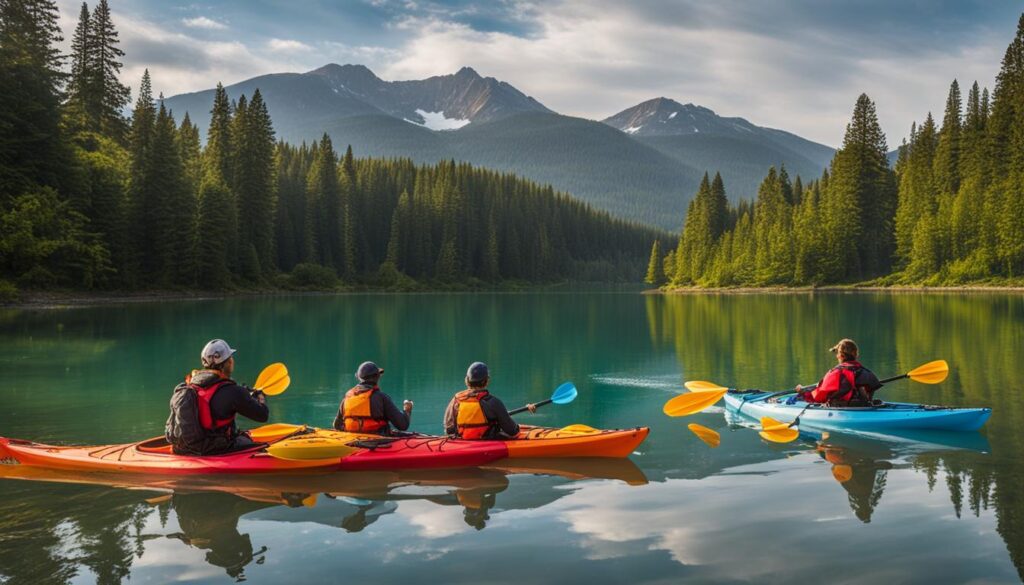
Planning a Suitable Itinerary
When organizing a group kayak camping trip, planning a suitable itinerary is essential for a smooth and enjoyable experience. Consider the skill levels and preferences of the group when choosing a route and camping locations. Research the area to identify any hazards or regulations that may affect your trip. It’s also important to plan for possible bailout points in case of emergencies and to ensure everyone’s safety.
Additionally, incorporating kayak camping activities for groups can enhance the overall experience. Fishing, swimming, bird-watching, or exploring nearby attractions can add excitement and variety to the itinerary. By catering to everyone’s interests and creating a well-rounded schedule, you can ensure that each member of the group has a memorable and fulfilling experience.
When planning the itinerary, consider the duration of the trip and the pace at which the group wants to kayak. Factor in breaks for rest, meals, and relaxation. It’s important to strike a balance between adventure and relaxation to avoid exhausting the group. By carefully planning and coordinating the itinerary, you can create a memorable group kayak camping trip that meets the needs and expectations of everyone involved.
Section 5: Prioritizing Safety Practices in Group Kayak Camping
When embarking on a group kayak camping trip, prioritizing safety is of utmost importance. By following proper safety practices, you can ensure a secure and enjoyable experience for everyone involved. Here are some essential safety tips to keep in mind:
- Dress appropriately: Always wear the right gear for the water temperature and weather conditions. Be sure to have appropriate layers, including a wetsuit or drysuit if necessary, and always wear a personal flotation device (PFD).
- Practice kayak rescue techniques: It’s crucial to be familiar with kayak rescue techniques, such as self-rescue and assisted rescue. Regularly practice these techniques to enhance your skills and confidence on the water.
- Inform others of your plans: Before heading out on your trip, make sure to inform family or friends of your trip plans, including your itinerary and expected return date. This way, someone will be aware of your whereabouts in case of an emergency.
- Carry essential safety equipment: Always have a well-stocked first aid kit and carry essential safety equipment, such as a signaling device, a throw line or tow rope, and a spare paddle. Stay updated on local weather reports and be prepared for any unforeseen situations.
By adhering to these safety practices and ensuring that everyone in your group is aware of them, you can minimize risks and have a safe and enjoyable group kayak camping trip.
“Safety first, adventure second. Always be prepared and prioritize the safety of yourself and your group. It’s better to be over-prepared than underprepared.”
Table: Essential Safety Equipment for Group Kayak Camping
| Item | Description |
|---|---|
| Personal Flotation Device (PFD) | An essential safety device that ensures buoyancy and helps keep you afloat in case of an accident. |
| Signaling Device | Includes items such as a whistle, mirror, or flares to attract attention in case of an emergency. |
| First Aid Kit | Contains basic medical supplies to treat injuries or illnesses that may occur during the trip. |
| Throw Line or Tow Rope | Used for rescuing someone in the water or towing a kayak in case of equipment failure. |
| Spare Paddle | Carrying a spare paddle is essential in case your primary paddle gets lost or damaged during the trip. |
Remember, safety is key when it comes to group kayak camping. By being prepared and following these safety practices, you can have a memorable and worry-free adventure on the water.
Gear and Clothing Recommendations
When it comes to gear and clothing for your group kayak camping trip, it’s important to pack efficiently and choose the best options. Here are some recommendations to ensure you have everything you need:
Essential Gear
- Kayak: Choose a kayak suitable for your skill level and the type of water you’ll be paddling in.
- Personal Flotation Devices (PFDs): Each member of your group should have a properly fitting PFD.
- Dry Bags: Keep your gear dry and organized by packing it in waterproof dry bags.
- Sunglass Tethers: Prevent losing your sunglasses in the water by using sunglass tethers.
- Water Shoes: Invest in a pair of sturdy water shoes that provide traction and protection.
- Kayak Seat: Enhance comfort during long paddling sessions with a comfortable kayak seat.
- Navigation Tools: Bring a map, compass, and GPS device to navigate your route.
Appropriate Clothing
- Baselayers: Pack moisture-wicking baselayers to keep you dry and comfortable.
- Quick-Drying Pants: Opt for lightweight, quick-drying pants for easy movement.
- Fleece Mid-Layers: Layer up with fleece mid-layers to stay warm in cooler weather.
- Rainwear: Be prepared for wet weather with a reliable raincoat and rain pants.
- Protective Headwear: Wear a hat or cap to shield your face from the sun.
Table: Recommended Gear and Clothing for Group Kayak Camping
| Item | Description |
|---|---|
| Kayak | Choose a kayak suitable for your skill level and the type of water you’ll be paddling in. |
| Personal Flotation Devices (PFDs) | Each member of your group should have a properly fitting PFD. |
| Dry Bags | Keep your gear dry and organized by packing it in waterproof dry bags. |
| Sunglass Tethers | Prevent losing your sunglasses in the water by using sunglass tethers. |
| Water Shoes | Invest in a pair of sturdy water shoes that provide traction and protection. |
| Kayak Seat | Enhance comfort during long paddling sessions with a comfortable kayak seat. |
| Navigation Tools | Bring a map, compass, and GPS device to navigate your route. |
| Baselayers | Pack moisture-wicking baselayers to keep you dry and comfortable. |
| Quick-Drying Pants | Opt for lightweight, quick-drying pants for easy movement. |
| Fleece Mid-Layers | Layer up with fleece mid-layers to stay warm in cooler weather. |
| Rainwear | Be prepared for wet weather with a reliable raincoat and rain pants. |
| Protective Headwear | Wear a hat or cap to shield your face from the sun. |
By packing the right gear and clothing for your group kayak camping trip, you’ll be well-prepared to enjoy the adventure and make lasting memories. Remember to choose items that are lightweight, practical, and suitable for the weather conditions you’ll encounter. Happy paddling!
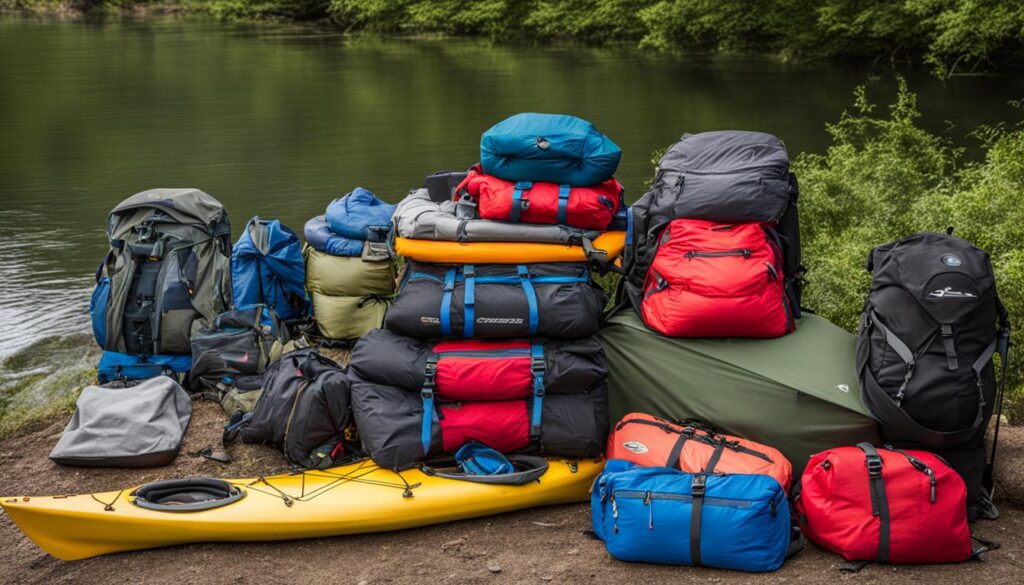
Choosing a Suitable Campsite
When planning a group kayak camping trip, one of the key considerations is choosing a suitable campsite. The campsite you select will greatly impact the overall experience of your adventure. To ensure a successful and enjoyable trip, there are several factors to keep in mind.
Firstly, consider the accessibility of the campsite. Look for a location that provides easy access to the water, as this will make launching and docking your kayaks much more convenient. Additionally, ensure that there is ample space at the campsite to set up your tents and other camping gear comfortably.
Another important factor is understanding any local regulations or restrictions. Some areas may have specific rules regarding camping or restrictions on where you can pitch your tents. It’s essential to research and comply with these guidelines to avoid any issues.
Lastly, take the surrounding environment into account. Consider the potential hazards, such as wildlife or unstable terrain, and choose a campsite that minimizes these risks. It’s also important to respect any wildlife habitats and be mindful of leaving no trace.
By carefully selecting a suitable campsite that meets the needs and preferences of your group, you can enhance the overall camping experience and create lasting memories.
Conclusion
Planning and organizing a group kayak camping trip requires careful consideration of gear, safety practices, group dynamics, and itinerary planning. By following the tips and ideas outlined in this article, you can ensure a successful and unforgettable adventure with your friends.
Remember to prioritize safety by dressing appropriately for the water temperature, wearing personal flotation devices (PFDs), and practicing proper kayak rescue techniques. Effective communication within the group is key to a smooth and enjoyable trip, so assign responsibilities and promote teamwork. Creating an inclusive environment where everyone feels valued and included will make the experience even more special.
With proper planning and preparation, your group kayak camping trip will be a memorable experience that strengthens friendships and creates lifelong memories. So pack the right gear, consider the dynamics of your group, plan a suitable itinerary, and prioritize safety. Get ready to embark on an adventure that you and your friends will cherish for years to come!
FAQ
What gear do I need for a group kayak camping trip?
It’s important to pack appropriate clothing, camping essentials, safety equipment, and kayak gear. This includes clothing layers, rainwear, sleeping bag, tent or hammock, camp stove, cook kit, water dromedary, kayak, personal flotation devices, first aid kit, and signaling devices.
How can I ensure smooth group dynamics during a kayak camping trip?
Clear leadership and communication within the group, assigning responsibilities, promoting teamwork, and understanding each other’s strengths and limitations can help create a cohesive and supportive environment for everyone.
How should I plan the itinerary for a group kayak camping trip?
Consider the skill levels and preferences of the group, research the area for hazards and regulations, plan for possible bailout points, and incorporate kayak camping activities that cater to everyone’s interests. This will enhance the overall experience for the group.
What safety practices should I prioritize during a group kayak camping trip?
Dress appropriately for the water temperature, wear personal flotation devices at all times, practice kayak rescue techniques, inform others of your trip plans and whereabouts, carry a first aid kit, and have a communication device in case of emergencies.
What gear and clothing should I pack efficiently for kayak camping?
Utilize dry bags for waterproof storage, secure your sunglasses with sunglass tethers, choose good water shoes, and consider a comfy kayak seat for enhanced comfort. Pack lightweight and practical essentials, dress in layers with quick-drying materials, and bring rainwear for comfort and protection.
How do I choose a suitable campsite for a group kayak camping trip?
Look for a campsite with easy access to the water and ample space for setting up camp. Consider local regulations, wildlife habitats, and potential hazards. By selecting a suitable campsite, you can enhance the overall camping experience for the group.


